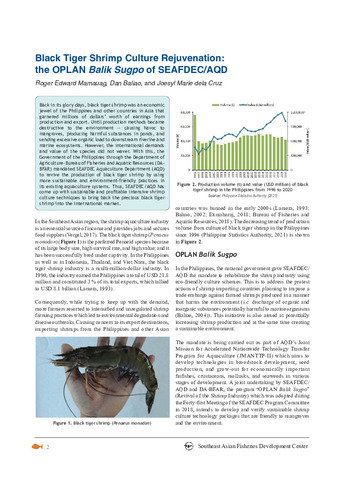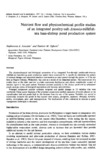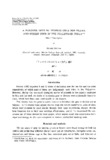Black tiger shrimp culture rejuvenation: the OPLAN Balik Sugpo of SEAFDEC/AQD
- Global styles
- MLA
- Vancouver
- Elsevier - Harvard
- APA
- Help

View/
Date
2021Page views
1,024ASFA keyword
AGROVOC keyword
Taxonomic term
Metadata
Show full item record
Share
Abstract
Back in its glory days, black tiger shrimp was an economic jewel of the Philippines and other countries in Asia that garnered millions of dollars’ worth of earnings from production and export. Until production methods became destructive to the environment — causing havoc to mangroves, producing harmful substances in ponds, and sending excessive organic load to downstream riverine and marine ecosystems. However, the international demands and value of the species did not waver. With this, the Government of the Philippines through the Department of Agriculture-Bureau of Fisheries and Aquatic Resources (DABFAR) mandated SEAFDEC Aquaculture Department (AQD) to revive the production of black tiger shrimp by using more sustainable and environment-friendly practices in its existing aquaculture systems. Thus, SEAFDEC/AQD has come up with sustainable and profitable intensive shrimp culture techniques to bring back the precious black tiger shrimp into the international market.
Suggested Citation
Mamauag, R. E., Baliao, D., & Cruz, J. M. d. (2021). Black tiger shrimp culture rejuvenation: the OPLAN Balik Sugpo of SEAFDEC/AQD. Fish for the People , 19(2), 2-7. http://hdl.handle.net/20.500.12066/6694
Type
magazineArticleCollections
- Fish for the People [41]
Related items
Showing items related by title, author, creator and subject.
-
Asian shrimp situation
Carreon-Lagoc, Julia; Southeast Asian Fisheries Development Center, Aquaculture Department (Aquaculture Department, Southeast Asian Fisheries Development Center, 1990) -
Nutrient flow and physicochemical profile studies of an integrated poultry-salt-Artemia-milkfish-sea bass-shrimp pond production system
Jumalon, Nepheronia A.; Ogburn, Damian M. (Wetteren, Belgium: Universal Press, 1987)The physicochemical and biological parameters of an integrated flow-through poultry-salt-Artemia-milkfish-sea bass-shrimp pond production system were monitored for 6 months to determine the pattern of nutrient changes and ... -
A further note to “fishing gear for prawn and shrimp used in the Philippines today”
Motoh, Hiroshi (Carcinological Society of Japan, 1983)Motoh (1980) reported 9 and 13 kinds of shrimping gear for the fry and the adult respectively, of which most of them are indigenously used today in the Philippines. Howerver, druing the continued ecological survey of ...







